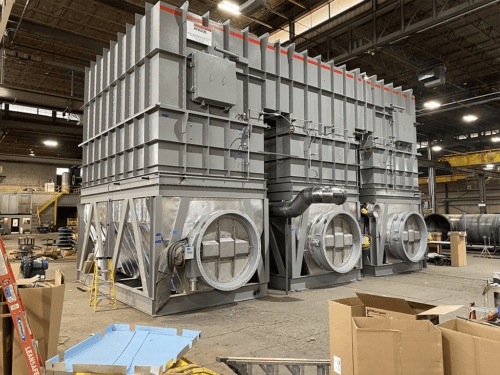Effective air pollution control is important in modern industrial facilities where the goals of ensuring regulatory compliance, minimizing environmental impacts, and maintaining a healthy bottom line, are all closely interlinked.
Regenerative thermal oxidizers—sometimes abbreviated to RTOs—can play a crucial role in eliminating hazardous air pollutants (HAPs) and volatile organic compounds (VOCs) from industrial emissions efficiently and cost-effectively. So, what is a regenerative thermal oxidizer and how does it work?
What are Thermal Oxidizers?

Anguil Three Chamber RTO in Fabrication
Thermal oxidizers are specialised combustion devices integrated into the ventilation of industrial processes that generate potentially harmful pollutants. Exhaust fumes travel through the oxidizer, which is heated to temperatures in the region of 1500°F, causing HAPs and VOCs to break down and form harmless compounds like carbon dioxide and water vapour. These can then be discharged into the atmosphere.
Although highly effective at destroying HAPs and VOCs, the problem with traditional thermal oxidizers is their extremely poor thermal efficiency. All heat energy employed in a conventional, direct-fired thermal oxidizer or vapor combustor is lost out the stack. An easy way to combat this is to employ a heat exchanger to recuperate thermal energy, but so-called thermal recuperative oxidizers (TROs) are limited to around 80% heat recovery rates and VOC destruction efficiencies of 99%.
There is a better solution that guarantees industrial compliance, reaches destruction efficiencies of 99+%, and offers thermal energy recovery efficiencies of up to 97%: regenerative thermal oxidizers.
Regenerative Thermal Oxidizer Design Principles
TROs tend to use standard metallic shell-and-tube heat exchanger systems, while regenerative thermal oxidizers use ceramic media beds with higher thermal efficiencies. In a dual-bed regenerative thermal oxidizer, incoming process emissions are drawn or pushed through the first ceramic bed via a high-pressure fan and pneumatic flow control valves.
The dirty stream exits the ceramic bed into the combustion chamber where burners rapidly break down contaminated compounds with a destruction efficiency greater than 99%. This purified stream is sent through a secondary ceramic bed where it relinquishes as much as 97% of its heat value into the exchange medium.
Regenerative thermal oxidizers reuse this recovered heat by periodically reversing the flow direction, courtesy of the pneumatic valves. The ceramic bed that recuperated heat from the purified stream is then used to preheat the incoming emissions, while clean, cool air is exhausted into the atmosphere.
This is not the only configuration, but it is the simplest one to gain a basic understanding of how regenerative thermal oxidizers work. Alternative systems include multi-chamber designs, although the same general principles apply.
Benefits of Regenerative Thermal Oxidizers
While some of the advantages of regenerative thermal oxidizers may be self-evident from their working principles, the extent of their value deserves further exploration. High-performance regenerative ceramic beds can enable fuel-free operation at very low VOC concentrations, as the cyclic flow reversal is so effective at reclaiming heat. Standard regenerative thermal oxidizers subsequently deliver extremely low operating costs for high air flow fume streams with low VOC concentrations.
Regenerative Thermal Oxidizers from Anguil
Anguil is one of the leading regenerative thermal oxidizer manufacturers worldwide. Our solutions are tried-and-trusted by business units across the global industrial landscape, because we understand the need to achieve multiple goals in tandem when it comes to selecting new air pollution control systems. Our cutting-edge regenerative thermal oxidizers guarantee compliance with the relevant industrial regulations, while ensuring the maximum process efficiency and system lifetime expectancy.
Want to learn more? Head over to our contact page to get in touch with an applications specialist or submit your project specifications directly and we will get back to you as soon as possible with equipment sizing, estimated operating costs, and delivery times.
